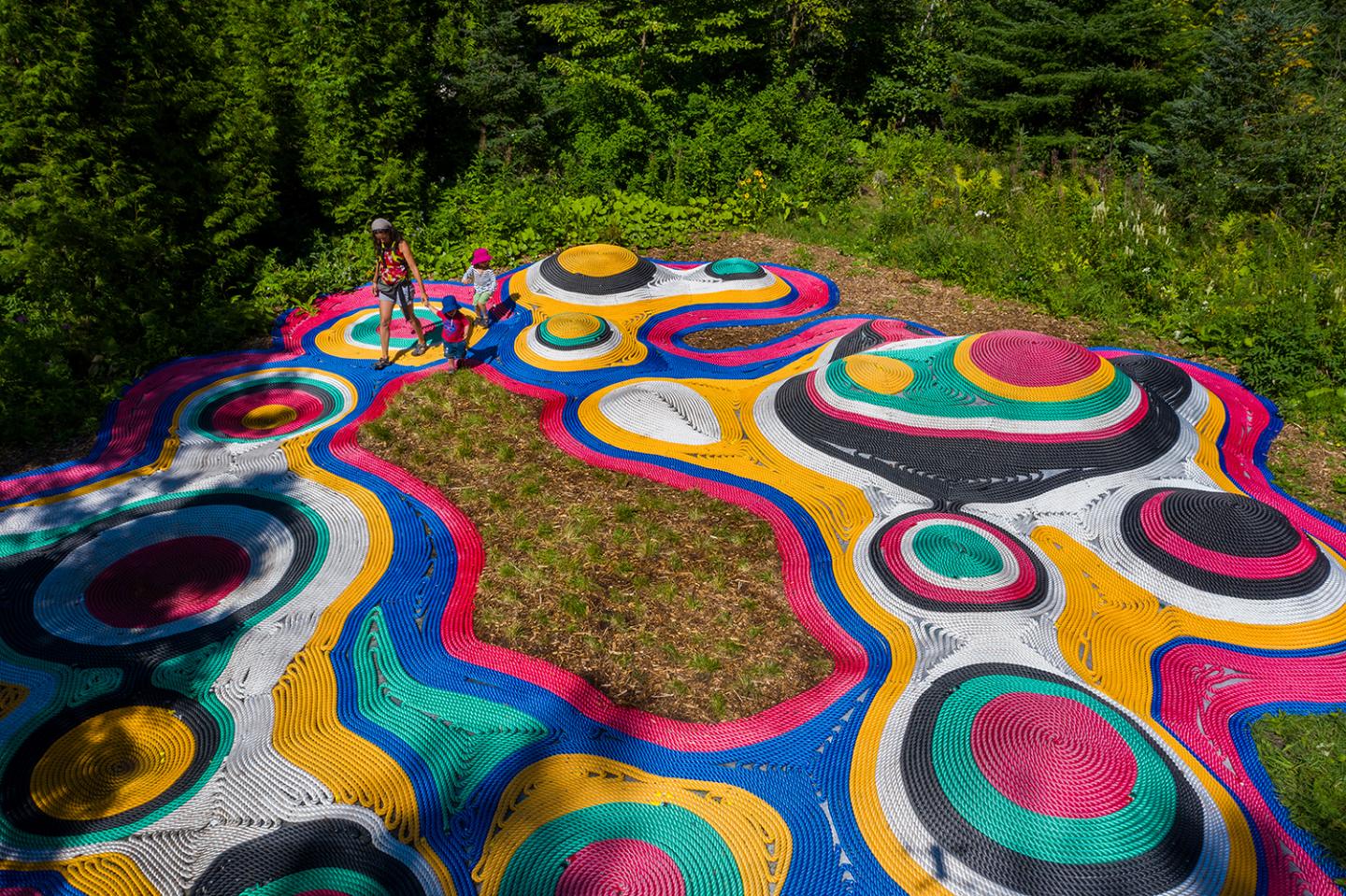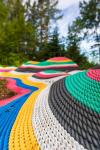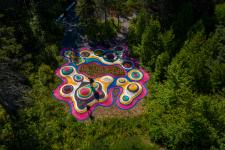Augmented Grounds is a winning competition entry of the International Garden Festival 2020. It is a landscape design installation, located in the Métis garden, Prince, Quebec, Canada, completed its construction in July 2020. The design is inspired by traditional Métis sash and the proposal uniquely combines technologies in its making process which was highly evaluated by the competition juries.
The project utilized Augmented Reality and cloud based digital twin communication platforms in order to realize the construction during the pandemic. The project celebrates the fast and intuitive communication between designer and maker, utilizing the digitally augmented human labours crafting the delicate material on site by wearing AR Lenses. At the same time, a globally assembled team of designers were able to review the construction process through a cloud based digital twin of the construction site, being able to intuitively supervise the construction process from far distance and pass on knowledge and guidance to local crews efficiently. This enabled the global team of designers and makers to be able to work together simultaneously in distance during the design and construction process.
The installation also celebrates human craftsmanship. We chose to use colorful rope inspired by the colours and history of the traditional Métis sash, the Augmented Grounds garden takes visitors through a playful and colourful rope display of topography that reflects the pride of Métis culture and identity. In the garden, visitors can walk along the colorful contours of ropes, sit and lie down on the coiled seating, or run up and down on the mounds and the pools.
This garden is the Métissage of cultural pride and innovation. The Métis sash is traditionally made with the art of finger weaving, and draped across one’s shoulder or tied around the waist. The Augmented Grounds garden represents the Sash through colourful ropes made of twisted fibres that are tightly laid on top of the terrain to create a landscape of contours that reflects the different depths of Métis history represented on the sash. While the experience of the installation being highly analogue, the construction process of this topographic terrain contributes to a new innovative practice of garden design by introducing smart construction technology using augmented reality. As the geometry is generated based on a mathematical algorithm, the combination of traditional materiality and mathematical form surrounded by the beautiful forest of Reford Garden provides a unique experience for visitors to truly experience the product of collaboration between human, computer & nature.
About the team
The team consists of architects and landscape architects, experts in design research and practice, interested in exploring harmonious ecology of human, computer and machine. Currently focusing on ways of constructing computationally generated complex forms by augmented human builders – augmented by AR devices or wearables etc. – to develop unique construction processes that cannot be done by pure automation nor by pure human labour. During pursuing various expertise in their field individually in both academia and practice, the team collaborates for various projects such as design workshops, research papers and competitions to pursue their research agenda.
Post Pandemic
The hit of pandemic alarmed humanity to re-think about the modes of working and communication which will inevitably facilitate the change in the way we shape our physical spaces in the near future. Our future office may just be wherever we have an internet connected. Many thinkers are already seeing the impact of this, some think it might mean the end of office space, working from anywhere and everywhere will be predominantly the modes of future work. This also challenges the architecture discipline and construction industry, urging us to propose new modes of production that can immediately adapt to ever changing society and industry. Architects are facing challenges on the way to adapt Intuitive communication methods and technologies into design and making process.
To challenge this idea, Augmented Grounds frontiered in this experimentation. The installation was built through a manual crafting process by augmented human builders who were wearing Augmented Reality devices. The data projected in the AR device was provided by the remote design team who have been constantly reviewing the construction site remotely online through a cloud based digital twin of the construction site. This exemplifies the future way of working and collaborating from distance, provides as a good use case of the existing technologies and at the same time pushes and challenges the technologies in this industry.
2020
2020
Official website:
http://www.internationalgardenfestival.com/
https://soomeenhahm.com/portfolio-item/augmented-grounds-copy/
Digital twin:
https://kohxslz.cupix.works/sv/a60b1q
*Powered by CupixWorks
Time Line:
Concept design by 2019.12.
Construction finished on 2020.07.09
Location:
Les Jardins de Métis / Reford Gardens
200, route 132
Grand-Métis, Quebec, Canada
Size:
12m x 12m
112 m2
Design Credit:
Soomeen Hahm (SD Ltd / SCI-Arc)
Yumi Lee (Seoul National University)
JaeHeon Jung (KOH SX Studio Inc.)
Co-project Leader:
Hanjun Kim (SD Ltd)
Local Construction Team:
Marie-Eve Brais (Leading construction member)
Justine Valois
Marion Sellier
François Leblanc (Site Organizer)
VR/AR/XR Remote Construction System Development:
KOH SX Studio Inc.
SLZ Inc.
Student Collaborators:
Jiin Jeong (SCI-Arc B.Arch)
YooMin Jeong (SNU Evolving Landscape Lab)
Christine Lee (SNU Evolving Landscape Lab)
Jeong-Hwan Lee (SNU Evolving Landscape Lab)
Sejun Oh (SNU Evolving Landscape Lab)
ZaiXian Piao (SNU Evolving Landscape Lab)
Gi-Hwan Yook (SNU Evolving Landscape Lab)










